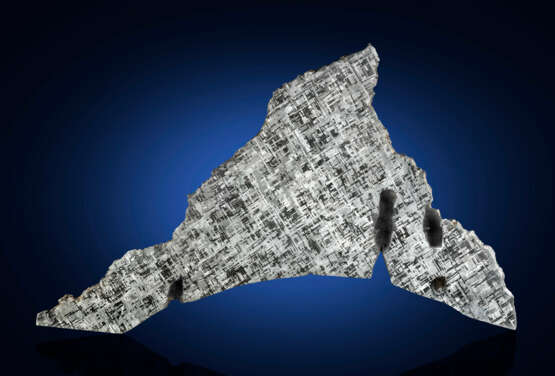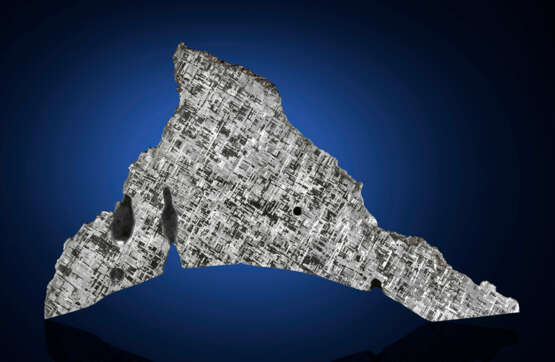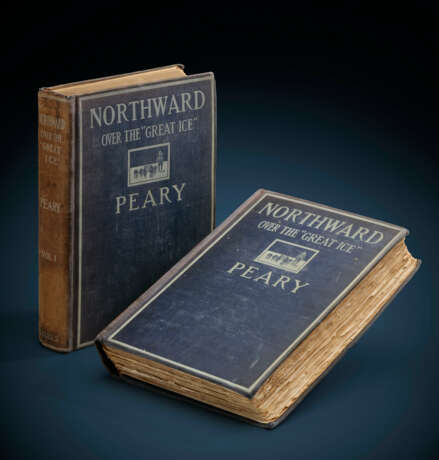ID 927021
Lot 30 | LARGE CAPE YORK SLICE — AMONG THE MOST HISTORIC METEORITES OF ALL TIME
Estimate value
$ 40 000 – 70 000
In 1818, Royal Navy Captain John Ross became icebound in Greenland while searching for the Northwest Passage. A tribe of Inuit, never before encountered by Europeans, came to trade with their unexpected guests. Ross and his crew were perplexed by the knives and harpoons offered that had been forged from iron. Days later the Innuit returned with more metal from an “iron mountain” and explained the only reason they traveled to this region was to tap into this resource. Ross wanted to send a search party to investigate this source of malleable metal and expressed regret in his captain’s log for not being able to do so. Upon his return to England, the legend of the “Iron Mountain” was born.
For decades numerous expeditions searched for the source of the iron with no luck. In 1891, nearly 75 years after Ross’s expedition, United States naval officer Robert Peary visited northern Greenland for the first time. Peary became obsessed with finding a route to the North Pole…as well as recovering the Inuit’s source of iron. He had learned these were meteorites from analyses of the tools which had previously been obtained — and then he learned there were multiple large meteorites. The Inuit were secretive about the location of the iron, as their way of life depended on it and they were concerned the explorers might seize it. However, in 1894 he was able to get an Inuit to take him to the locality and he did indeed seize the second and third largest meteorites and brought them to New York City. In 1897 he returned to Greenland with a personal photographer in tow, to retrieve the largest of the meteorites — photos of which are published in Peary’s two volume Northward Over the “Great Ice” which accompanies this lot. It was an extraordinary undertaking to both move and load the 31-ton meteorite onto his ship and Peary returned to New York City to a hero’s welcome. Having now deprived the Inuit of their source of iron, Peary gave them guns and ammunition, pots, pans, knives and spearpoints to offset their loss. To this day this is the largest single meteorite ever recovered; on display at the American Museum of Natural History, it’s so heavy that the armature which supports it had to be anchored directly into Manhattan’s bedrock prior to the construction of the museum extension which houses it.
In 1963, a young Dr. Vagn Buchwald, who would soon join the ranks of the world’s greatest meteoriticists, ventured to Greenland and discovered an additional 20-ton mass of Cape York. On display at the University of Copenhagen, the two Cape York specimens in this sale are derived from this mass.
The current offering is a rare massive partial slice with two long ridges of the meteorite’s exterior and a long, tapered arc along the base. At its widest this partial slice is 13 mm thick and it tapers toward the edge. An extremely robust etch is seen on both sides with two elongated amoeboid troilite inclusions on the left edge along with two additional circular troilite inclusions. Its elemental composition is approximately 90.2% iron, 7.8% nickel, and 2% minor and trace elements. The dazzling octahedral latticework seen, referred to as a Widmanstätten pattern, is unique to meteorites, and only those that contain about 6% -18% nickel). As Van Buchwald stated, “Probably no other meteorite has been so intimately connected with the life and fate of so many people as Cape York.” This is a notable offering of a large format partial slice from one of the most famous and legendary meteorites.
Christie's would like to thank Dr. Alan E. Rubin at the Department of Earth, Planetary, and Space Sciences, University of California, Los Angeles for his assistance in preparing this catalogue.
765 x 405 x 10mm (30 x 16 x 0.33 in.) and 9.59 kg (21 lbs)
| Address of auction |
CHRISTIE'S 20 Rockefeller Plaza 10020 New York USA | ||||||||||||||
|---|---|---|---|---|---|---|---|---|---|---|---|---|---|---|---|
| Preview |
| ||||||||||||||
| Phone | +1 212 636 2000 | ||||||||||||||
| Fax | +1 212 636 4930 | ||||||||||||||
| Conditions of purchase | Conditions of purchase | ||||||||||||||
| Shipping |
Postal service Courier service pickup by yourself | ||||||||||||||
| Payment methods |
Wire Transfer | ||||||||||||||
| Business hours | Business hours
|





